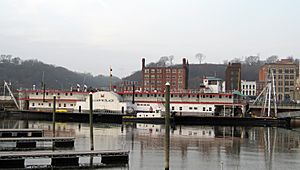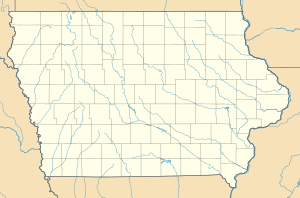William M. Black (dredge) facts for kids
 |
|
| History | |
|---|---|
| Name | William M. Black |
| Owner |
|
| Builder | Marietta Manufacturing Co. |
| Launched | 1934 |
| Status | Museum ship |
| General characteristics | |
| Type | Dustpan dredge |
| Length | 277 ft (84 m) |
| Beam | 85 ft (26 m) |
| Depth | 8 ft 6 in (2.59 m) |
| Installed power |
|
| Propulsion | Sidewheels |
| Crew | 49 |
|
William M. Black (dredge)
|
|
| Location | Third Street at the Ice Harbor, Dubuque, Iowa |
| Built | 1934 |
| Architect | Marietta Manufacturing Co. |
| NRHP reference No. | 82002618 |
| Significant dates | |
| Added to NRHP | 12 April 1982 |
| Designated NHL | 27 April 1992 |
The William M. Black is a special kind of ship called a dustpan dredge. It uses steam power and has big paddlewheels on its sides. This ship is named after William Murray Black. Today, it's a museum ship you can visit in Dubuque, Iowa.
It was built way back in 1934. The William M. Black is one of the few steam-powered dredges left. It's also one of only four dredges from the United States Army Corps of Engineers that still exist. In 1992, it was named a National Historic Landmark. You can take tours of the ship as part of the National Mississippi River Museum & Aquarium.
What is the William M. Black?
The William M. Black is located in the Dubuque Harbor. You can find it where Ice Harbor Drive meets East 3rd Street. This ship has a strong steel body. It is 277 feet (84 meters) long. It is 85 feet (26 meters) wide, including the boxes for its paddlewheels.
The ship's main body is 8.5 feet (2.6 meters) deep. It has a flat front end, like a scow. It does not have a keel, which is a fin on the bottom of many ships. The ship has three decks on top. These decks are held up by strong steel beams. This design allowed heavy equipment to be placed anywhere on the ship.
How the Dredge Worked
The "dustpan dredge" part is at the front of the ship. This is the equipment that sucks up mud and sand. Strong cables on each side held the ship in place. This kept it steady while it was dredging. The paddlewheels are about two-thirds of the way down the ship's body.
The big pump for the dredge was at the front. Its steam engine was right behind it. One of the ship's original paddlewheels has been taken off. You can see it on display at the museum grounds.
Life on the River
The William M. Black was one of the last paddle steamers built in the United States. It mostly worked along the Missouri River. Its job was to keep the river channels deep enough for other boats to pass.
The ship had a crew of 49 people. Every day, it could dredge about 80,000 cubic yards (61,000 cubic meters) of material. That's a lot of mud and sand! The ship stopped working in 1973. This was because it used a huge amount of heavy oil, about 7,000 gallons (26,000 liters) each day. During the 1973 oil crisis, this became too expensive.
See also


